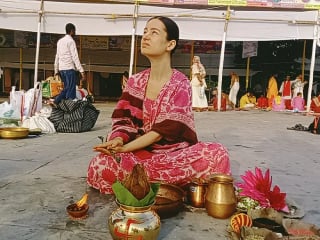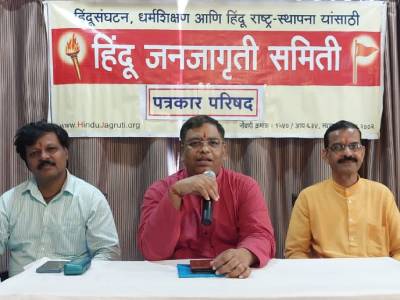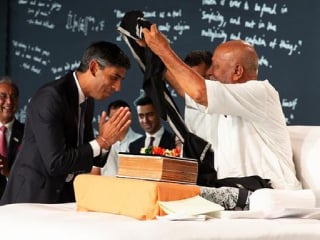Shravan Amavasya, Kaliyug Varsha 5116
 |
Janakpur holds the same place for the Hindus as Vatican is to the Christians, Mecca is to the Muslims, Lumbini is to the Buddhists or Jerusalem is to the Jews. It used to be the capital city of ancient Mithila or Videha state and it became the most sacred land after Goddess Sita was born here during the Ramayanic period some ten thousand years ago. Following the Sugauli Treaty in 1816, Janakpur along with some other regions of Mithila was ceded to Nepal; while the larger chunk of this state remained with British India. Janakpur has approximately 100,000 populations and it is at the distance of some 20 kilometres north of the Indian border.
Sita, the symbol shakti (power), was the daughter of Seeradhwaj Janak and wife of Lord Ram, the King of Ayodhya (India). The Hindus all over the globe worship Sita as the incarnation of Goddess Lakshmi and they find in her all the qualities of Lakshmi, Durga and Saraswati. No other God or Goddess made as much impact on the cultural life of the women in the Indian sub-continent as Sita did, which is unique in itself.
It was not without reason why Sita chose Janakpur as her birthplace. There is immense spiritual vibration on this land, which is unmatched anywhere on the earth. It is this vibration that time to time attracted the enlightened souls to visit that place – be it in the form of Janak, Sita, Ashtavakra, Yagnyavalkya or Gargi. Even Lord Ram had to come to this land of Janakpur along with his brother Lakshman and his teacher Vishwamitra in his bid to establish union with Sita.
At a time Mithila was ruled by the spiritually enlightened King Seeradhwaj Janak, Janakpur was the centre of spiritual learning for the entire population of Indian sub-continent. A number of scholars and philosophers in Mithila contributed through their spiritual teachings. The Ashtavakra Gita, propounded by Ashtavakra is most valuable spiritual text. Yagnyabalkya has his major contribution on universal self or Atman. Gargi, the female philosopher authored Gargi Samhita. Even enlightened spiritual master like Sukhdev had to come to Janakpur to get spiritual education from Seeradhwaj Janak.
When Buddhism flourished and was at its pinnacle of growth in the Indian sub-continent, Jagadguru Sankaracharya had to take the help of Mandan Mishra of Mithila in fight against Buddhism. So much so that Mishra's wife is said to have defeated even Shankaracharya in the scholarly discourse.
Janakpur boasts itself of Janaki Mandir, the magnificent temple in terms of architecture and design. The temple was constructed in 1898 AD by Brisahbhanu Kunwar, Queen of Tikamgadh state in Madhya Pradesh, India. Ram Mandir is equally revered for it has Ram Panchayatan Murti as built by Vishwokarma. Before Lord Ram left Janakpur for Ayodhyaya after his marriage, his father-in-law King Janak wanted to have this idol of Ram along with Sita. Nearby the Janaki temple is Vivahmandap, where Ram and Sita were wedded. Besides, Lakshman temple, Dulaha-Dulhin temple, Ratnasagar temple, Sankatmochan Hunuman temple and many other temples exist in this town. Also, the place where the wreckage of Dhanush (bow) that fell after Lord Ram broke it lies at the distance of some fifteen kilometers north of Janakpur.
Sadly though, Janakpur is most neglected, perhaps even more than what Ayodhya, Varanasi, Mathura or Prayag is in India. Virtually, Janakpur appears to be a kind of dying city today, if looked from the surface. All the one-hundred ponds of the city are highly polluted and they are getting encroached day by day. Bathing even in the holiest of the holy ponds like the Gangasagar and Dhanushkshetra has become risky for the health. These two ponds are revered as pure as the Ganga river is in India because it is believed to have connectivity to that river from inside the surface of the earth.
The temples are equally part of social life in Janakpur. However, most of the temples are getting encroached almost in the same way as the ponds are encroached. Construction of the shutters and shops in the front side of the temples has eroded their charms.
Also, the greenery has almost disappeared from Janakpur. Rarely any road does have plantation. It was only the circular road (parikrama sadak) around Janakpur that had tree cover. But over the years many of those plants have died. The Rangbhoomi maidan at some point of time was having thick trees, but now they have disappeared. There is hardly any park worth the name where people could relax under the greenery.
The condition of the infrastructural facilities, including the roads and sewerage is worse off. In most of the places, the height of both the roads and the drains is higher than that of the public buildings with the result that the city faces serious water logging problem, especially during the rainy season. There is hardly any outlet of the drains. Janakpur municipality could have addressed some of these problems, but its performance is dismal. Even the locals often dump the household garbage and plastic bags on the roads or in the drains with the result that there is water logging in various parts of the city. This has made this land a breeding ground for mosquitoes.
Also, the condition of the link roads that connect Janakpur with India, including Janakpur-Bhittamore road and Janakpur-Pipraon road, is far from satisfactory. Indian companies were given contract to construct the roads under the Nepal-India cooperation, but the contractors stopped working on these roads for reasons unknown. The only railway that Nepal does have, Janakpur Railway, connects Janakpur (Nepal) with Jaynagar (India). Under Nepal-India agreement, this railway line has to be converted into broad-gauze line, but there is very little progress.
An alternative to Janakpur to Jaynagar (India) railway in the form of road is not yet built, though Jaynagar has is now getting connected to different parts of India through the railway. The existing Janakpur Airport could also not be converted into regional or international airport. Work on the Indo-Nepalese project, Hulaqi Sadak (Postal Highway), connecting Nepal's eastern region with the western one through Janakpur suburb is yet to be completed.
Political will is also lacking for the development of Janakpur. Development of Janakpur came to standstill when a bomb was thrown on the vehicle of King Mahendra in early 1960s. Situation did not change for the better even after the political change in 1990 in which King Birendra lost much of his power and the multi-party system was revived. Maoist insurgency (1996 to 2006) gave still bigger blow to the development activities at Janakpur. The lack of law and order situation helped the dons, land mafias and other criminal elements to dominate the scene.
However, funding may not be a major problem for investment in the development activities in Janakpur, if there is a will for the development. The Asian Development Bank has offered over 2.5 billion Nepalese rupees for the road expansion and drainage construction and other such development activities at this place.
Somehow, Varanasi seems to have its face lift after more than six-and-half decades of Indian independence. This was possible after the Indian Prime Minister Narendra Modi won the recent 2014 Lok Sabha elections from Varanasi constituency. May the sacred land of Janakpur ever have its face lift in the same way as Varanasi is having now? Does Janakpur need another Modi-like personality in Nepal to ensure its development? Only time will tell how the future takes its course. But if the recent outburst of enthusiasm at Janakpur is any indicator, it becomes apparent that this land has awakened to regain its past glory. People of this land have started to demolish the public buildings in the process of road expansion, constructing drainage and rejuvenating the existing ponds through whatever meager means that they have.
During the Constituent Assembly 2 election in Nepal in November 2013, the Rastriya Madhesh Samajbadi Party in its political manifesto declared Janakpur as the spiritual capital of Nepal. In fact, this sacred land of Janakpur is not only the spiritual capital of Nepal alone, but it is so for all the Hindus living in different parts of the world.
Realizing the importance of Janakpur in strengthening Nepal-India relations, the Indian government made certain efforts to develop this city. Towards this end, the government of India helped renovate the Janaki temple. A Guest House was also constructed with Indian assistance. More recently, the government of India donated funds for the upgradation of Rangbhoomi and also for the renovation of sacred ponds of Gangasagar and Dhanushkshetra.
The Greater Janakpur Area Development Council, which was established decades ago was expected to launch certain development activities in and around Janakpur. It was also entrusted with the responsibility of making outer circular road around Janakpur covering part of Nepal and Indian border region. That would really have proved most useful project in promoting friendly relations between Nepal and India. But over the years the expectations of the people from the Council has largely been belied.
Agricultural and horticultural activities in and around Janakpur suffered a lot as most people in the region left for Malaysia, Gulf and other countries for the jobs. The only industrial unit of the land, Janakpur Cigarette Factory, was also closed.
Now to sum up, all the ponds that have been encroached and are either polluted or on the brink of extinction should be rejuvenated without any further delay. The temples have to be made clean and wherever possible their encroachment has to be stopped. Cleanliness of the roads and other public places is also essential for which garbage collection activities have to be made most efficient.
Equally important is buildings parks, hospitals, guest houses and vegetarian eateries for the pilgrims at Janakpur. Tree plantation has to be given priority at all important places in the city. Roads should be broadened and reconstructed as per the standard norm. The drainage with proper outlet and also with cover should be built so that mosquito problem is effectively addressed. Care should be taken to see that the height of the drainage is lower than the heights of the road and the public dwellings. For this, what is also needed is that the municipality of the town should fix a standard norm about the height of the foundation of the public buildings. This entails that no map-drawing is passed by the municipality unless it meets the specific standard. The school-going children and other sections of the society have to be educated to take whatever steps that is necessary to maintain cleanliness of the roads, ponds, temples and drainage system, apart from checking the encroachment of public places like the ponds and temples.
If the glory of Janakpur has to be revived, it is necessary that it should be developed as centre for learning in which emphasis is given for the spiritual education. With this regard, can the concerned agency in Nepal think of converting the closed Janakpur Cigarette Factory into Janakpur University with focus on spiritual, management, art, software, medical and technical education? Can also the link roads from Janakpur to Bhitamore (India), Janakpur to Pipraun (India) and alternative road between Janakpur and Jaynagar (India) be built without any delay? Can Janakpur Airport be converted into Regional or International Airport? Can Janakpur be linked with Benga-Piprarhi to enable the pilgrims to see the wreckage of bow as broken by Lord Rama during his marriage with Sita? Also, can the work on Hulaqi Sadak be completed without any further delay? This sacred land of Janakpur might re-emerge as world spiritual centre if focus is given on its development. Besides, it might also be a valuable monument in strengthening Nepal-India relations. Against this backdrop, Nepal should immediately declare a national holiday on the occasion of birthday of Sita, which would help glorify Janakpur. If done so, hundreds and thousands of devotees from Nepal, India and also from other parts of the world might come to Janakpur. This could promote religious tourism and become important source of earnings for Nepal.
Source : South Asian Analysis





